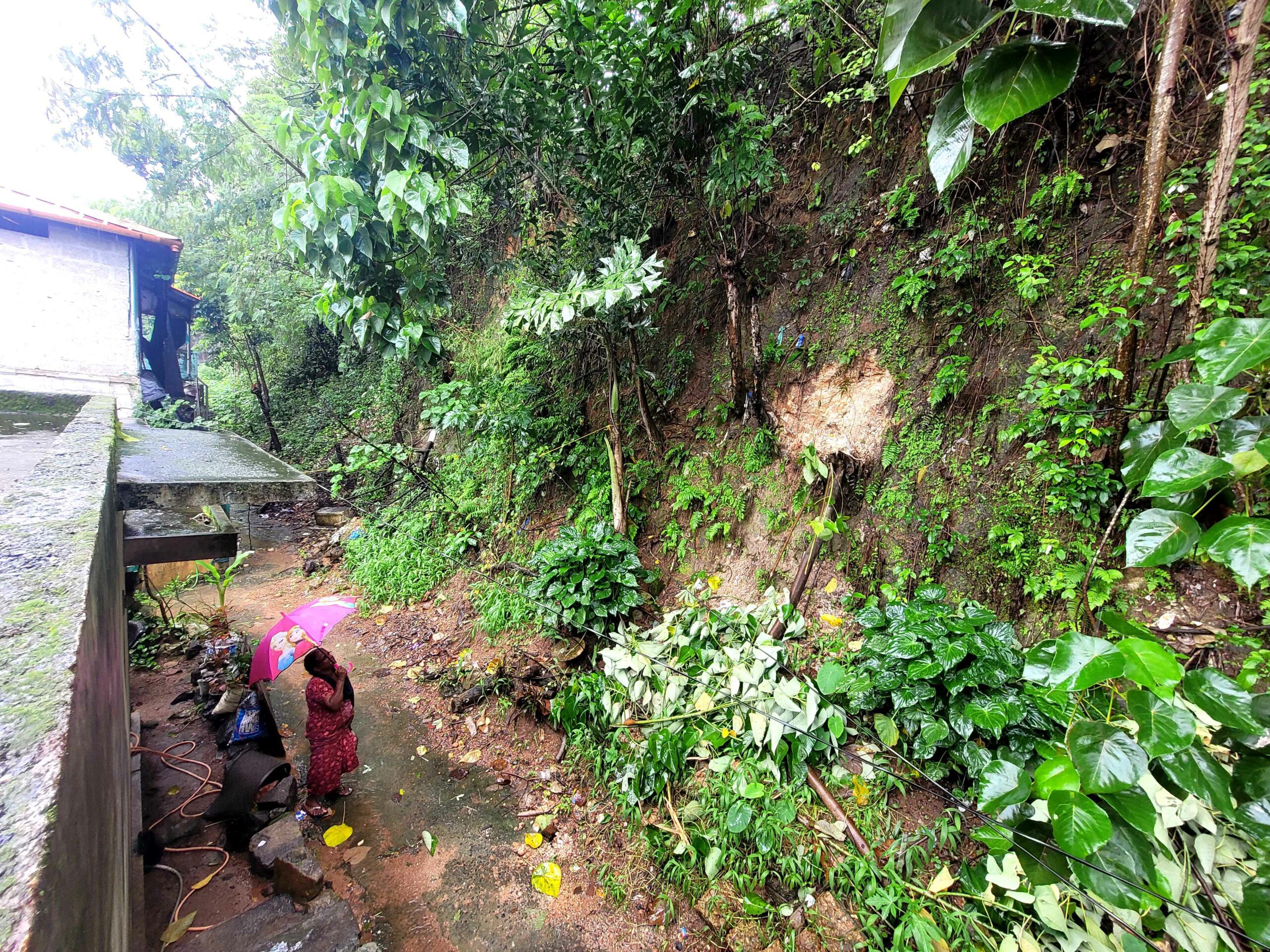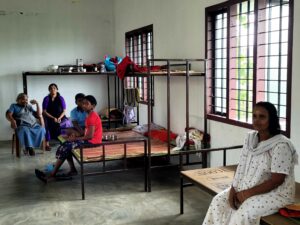Residents of Keerelimala Colony are forced to shift to relief camps every monsoon as a hillock towering over their homes pose a constant threat.

Molly looking up at the hillock. Minor landslips are common in the area. (George Michael/South First)
Call it irony. Upmarket Kakkanad in Kerala’s Ernakulam district is known for its several tech firms, employing thousands. But come monsoon, residents of Keerelimala Colony in the locality pack their bags and shift to relief camps.
The threat is constant, in the form of a hillock, imposing and threatening. It could send a landslide rolling down at any time, burying the houses at its foot.
This monsoon, too, the St Mary’s Malankara Church hall at Kakkanad has turned into a relief camp, temporarily sheltering 25 people from nine families, who left their homes fearing a landslide.
The shifting to the camp during monsoons has become a routine for the families, something they have been doing for the past four years.
Staying back in the colony means remaining awake, anticipating death in the form of tonnes of earth and rocks crashing onto their rooftops.
The sounds of people engaged in serious discussions and the clattering of utensils from the kitchen area fill the camp.

The residents at the relief camp in Ernakulam. (George Michael/South First)
The church hall is preparing for lunch. Manju KR, a resident of Keerelimala, is busy on the phone, enquiring about the well-being of the residents of Athani.
She has taken up the role of the coordinator at the relief camp. Manju’s strong connection with her community and firsthand experience of the challenges were evident in the words she shared with South First.
“If we don’t see a bit of sun in the coming weeks, our houses will be buried by trees and rocks which come down the hillock. A tree fell yesterday, barely missing one of the houses,” she said.
“The story is the same every year. Local authorities want us to vacate to the camp. They provide temporary homes, but we cannot afford the rent. We have no choice, but to return to the colony,” she said.
“The danger is the only constant, and the rains just make it worse,” Manju said before announcing that the lunch was ready.
Molly Joseph, a 63-year-old resident living at the foot of the landslide-prone hillock, has spent the last two decades worried.
Her modest home, nestled amidst the lush greenery, is under threat of trees uprooting on it.
Molly’s concerns are further compounded by the treacherous entrance to the colony — a flight of steps that pose a significant challenge, particularly to the elderly, during the monsoon season.
“These steps are treacherous during rains, most of the residents here are elderly. They cannot climb these stairs, especially during monsoons,” Molly explained as she took South First through the landside-prone locality.
The steps leading to the colony are slippery. For Molly, the picturesque locale in the midst of a busy city is an area of distress.
“I live at the foot of the hillock. Rubble and pieces of wood would be strewn all over the front yard every morning. I feel its just a matter of time that a major portion of the hill collapses on my rooftop,” she said.
Manju lives at the top of the hillock. She is worried that her home would be washed downhill.
“The authorities last year offered to provide us rent if we shifted. But rent money stopped coming after a few months. and we returned home,” Molly said.
Earlier, the authorities promised the colony a protective wall, which did not materialise.
“They make promises during elections and before the monsoons, and ask us to shift. We are being tossed around,” she added.
Manju said a handsome amount allotted to pay the rent just vanished last year. “We have been shuttling between relief camps and our homes for the past four years. We are tired,” she said.
“The funds never came through fully. It was from the chief minister’s disaster fund, but we received only a portion of the allocated amount. This issue will be sorted out this year as a proposal to build homes for them has been passed,” Ajitha Thankapan, former chairman of the Thrikakkara municipality, told South First.
Athani ward counsellor MJ Dixon confirmed that the proposal has been passed.
“Each family will be provided land and ₹4 lakh for housing purposes. The project will be underway in the next two months,” he said.
Those in the relief camp are not convinced. They remained sceptical. “Promises are nothing new, let it materialise,” Manju said.

Jul 26, 2024

Jul 26, 2024

Jul 25, 2024

Jul 25, 2024

Jul 25, 2024

Jul 24, 2024